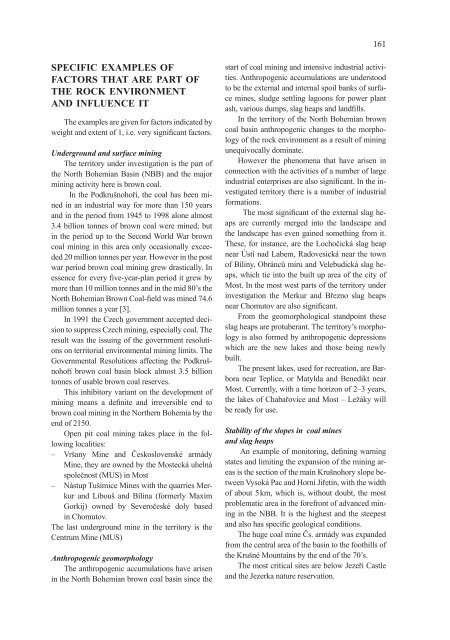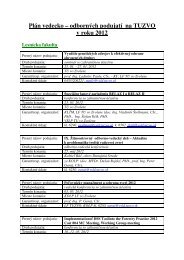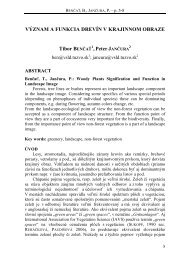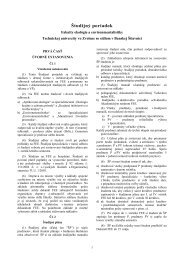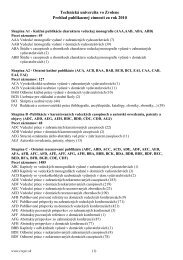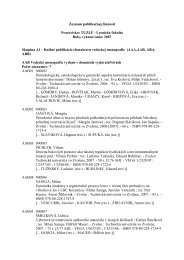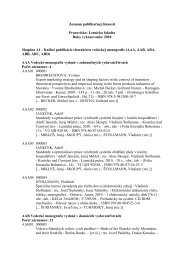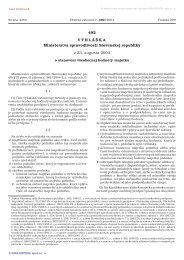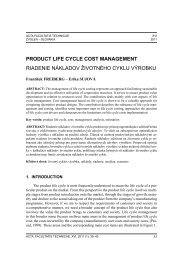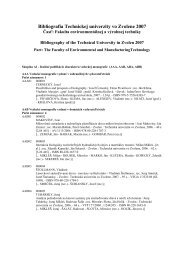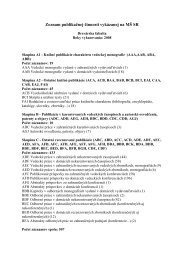Acta Facultatis Ecologiae - Technická univerzita vo Zvolene
Acta Facultatis Ecologiae - Technická univerzita vo Zvolene
Acta Facultatis Ecologiae - Technická univerzita vo Zvolene
- No tags were found...
You also want an ePaper? Increase the reach of your titles
YUMPU automatically turns print PDFs into web optimized ePapers that Google loves.
161SPECIFIC EXAMPLES OFFACTORS THAT ARE PART OFTHE ROCK ENVIRONMENTAND INFLUENCE ITThe examples are given for factors indicated byweight and extent of 1, i.e. very significant factors.Underground and surface miningThe territory under investigation is the part ofthe North Bohemian Basin (NBB) and the majormining activity here is brown coal.In the Podkrušnohoří, the coal has been minedin an industrial way for more than 150 yearsand in the period from 1945 to 1998 alone almost3.4 billion tonnes of brown coal were mined; butin the period up to the Second World War browncoal mining in this area only occasionally exceeded20 million tonnes per year. However in the postwar period brown coal mining grew drastically. Inessence for every five-year-plan period it grew bymore than 10 million tonnes and in the mid 80’s theNorth Bohemian Brown Coal-field was mined 74.6million tonnes a year [3].In 1991 the Czech government accepted decisionto suppress Czech mining, especially coal. Theresult was the issuing of the government resolutionson territorial environmental mining limits. TheGovernmental Resolutions affecting the Podkrušnohoříbrown coal basin block almost 3.5 billiontonnes of usable brown coal reserves.This inhibitory variant on the development ofmining means a definite and irreversible end tobrown coal mining in the Northern Bohemia by theend of 2150.Open pit coal mining takes place in the followinglocalities:– Vršany Mine and Československé armádyMine, they are owned by the Mostecká uhelnáspolečnost (MUS) in Most– Nástup Tušimice Mines with the quarries Merkurand Libouš and Bílina (formerly MaximGorkij) owned by Severočeské doly basedin Chomutov.The last underground mine in the territory is theCentrum Mine (MUS)Anthropogenic geomorphologyThe anthropogenic accumulations have arisenin the North Bohemian brown coal basin since thestart of coal mining and intensive industrial activities.Anthropogenic accumulations are understoodto be the external and internal spoil banks of surfacemines, sludge settling lagoons for power plantash, various dumps, slag heaps and landfills.In the territory of the North Bohemian browncoal basin anthropogenic changes to the morphologyof the rock environment as a result of miningunequi<strong>vo</strong>cally dominate.However the phenomena that have arisen inconnection with the activities of a number of largeindustrial enterprises are also significant. In the investigatedterritory there is a number of industrialformations.The most significant of the external slag heapsare currently merged into the landscape andthe landscape has even gained something from it.These, for instance, are the Lochočická slag heapnear Ústí nad Labem, Radovesická near the townof Bíliny, Obránců míru and Velebudická slag heaps,which tie into the built up area of the city ofMost. In the most west parts of the territory underinvestigation the Merkur and Březno slag heapsnear Chomutov are also significant.From the geomorphological standpoint theseslag heaps are protuberant. The territory’s morphologyis also formed by anthropogenic depressionswhich are the new lakes and those being newlybuilt.The present lakes, used for recreation, are Barboranear Teplice, or Matylda and Benedikt nearMost. Currently, with a time horizon of 2–3 years,the lakes of Chabařovice and Most – Ležáky willbe ready for use.Stability of the slopes in coal minesand slag heapsAn example of monitoring, defining warningstates and limiting the expansion of the mining areasis the section of the main Krušnohory slope betweenVysoká Pac and Horní Jiřetín, with the widthof about 5 km, which is, without doubt, the mostproblematic area in the forefront of advanced miningin the NBB. It is the highest and the steepestand also has specific geological conditions.The huge coal mine Čs. armády was expandedfrom the central area of the basin to the foothills ofthe Krušné Mountains by the end of the 70’s.The most critical sites are below Jezeří Castleand the Jezerka nature reservation.


